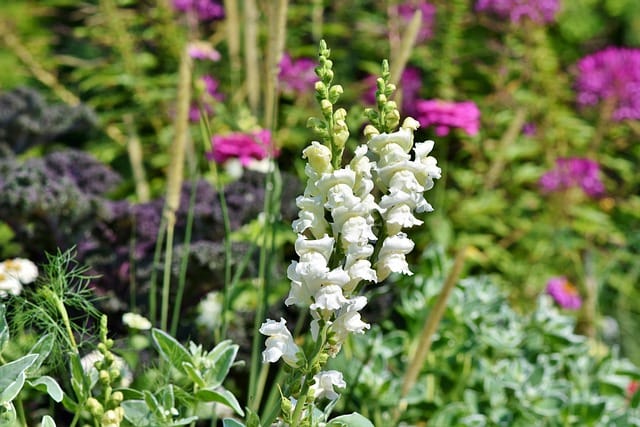How to grow Snapdragons
Snapdragons, also known as Antirrhinum, are beautiful and popular garden flowers

In this article:
- Introduction
- Choosing the Right Variety
- Suitable Climate and Growing Conditions
- Soil Preparation
- Planting Snapdragons
- Watering and Moisture Requirements
- Fertilizing Snapdragons
- Pruning and Staking
- Pest and Disease Management
- Harvesting and Cutting Snapdragons
- Saving Seeds
- Propagation Methods
- Companion Planting with Snapdragons
- Landscaping Ideas with Snapdragons
- Frequently Asked Questions (FAQs)
- Conclusion
Introduction
Snapdragons, also known as Antirrhinum, are beautiful and popular garden flowers. They are loved for their vibrant colors and unique snap-like appearance when the flowers are gently squeezed. Growing snapdragons can be a rewarding experience for any gardener, whether you are a beginner or an experienced horticulturist.
Choosing the Right Variety
There are various varieties of snapdragons available, each with its own unique characteristics. Some popular varieties include Rocket Mix, Madame Butterfly, and Liberty Classic. Consider factors such as size, color, and growth habit when selecting the right variety for your garden.
Suitable Climate and Growing Conditions
Snapdragons thrive in cool weather conditions and are typically grown as annuals or biennials. They prefer full sun but can tolerate some shade. Ensure that the chosen location for planting gives them at least 6-8 hours of sunlight per day and protection from strong winds.
Soil Preparation
Prepare the soil by removing any weeds, rocks, or debris. Snapdragons prefer well-draining soil with a pH range of 6.0-7.0. Add organic matter like compost or well-rotted manure to improve soil fertility and drainage.
Planting Snapdragons
Sow snapdragon seeds indoors 8-10 weeks before the last frost date. Transplant the seedlings into the garden bed once all danger of frost has passed and the soil has warmed up. Space the plants about 6-12 inches apart, depending on the variety's mature size.
Watering and Moisture Requirements
Water snapdragons regularly, ensuring that the soil remains evenly moist. Avoid overwatering, as it can lead to root rot and other fungal diseases. Mulching around the plants helps retain moisture and suppress weed growth.
Fertilizing Snapdragons
Feed snapdragons with a balanced slow-release fertilizer at planting time. Apply fertilizer again when the plants start to produce flowers. Follow the manufacturer's instructions for proper application rates and frequency.
Pruning and Staking
Pinch back the growing tips of young snapdragon plants to encourage bushier growth and more flowers. Stake taller varieties to prevent them from flopping over under their own weight. Prune off any dead or spent flowers to promote continuous blooming.
Pest and Disease Management
Monitor snapdragons regularly for common pests like aphids, spider mites, and snails. Use organic pest control methods whenever possible, such as handpicking or spraying with insecticidal soap. Keep an eye out for diseases like powdery mildew and rust, and promptly treat infected plants.
Harvesting and Cutting Snapdragons
Harvest snapdragon flowers when the bottom two to three flowers on the stem have opened fully. Cut the stem at an angle just above a pair of healthy leaves. Place the cut stems in a vase of water immediately to maximize their vase life.
Saving Seeds
If you want to save snapdragon seeds for future planting, allow some flowers to naturally wither and dry on the plant. Harvest the dried seed pods, remove the seeds, and store them in a cool and dry place until you are ready to use them.
Propagation Methods
Snapdragons can be propagated through seeds, division, or stem cuttings. Each method has its own requirements and advantages. Choose the propagation method that suits your needs and gardening preferences.
Companion Planting with Snapdragons
Snapdragons make great companions for various other garden plants. They attract beneficial pollinators like bees and butterflies, and also repel pests such as aphids. Consider planting snapdragons alongside plants like roses, petunias, and marigolds for a visually appealing and pest-resistant garden.
Landscaping Ideas with Snapdragons
Snapdragons can be used in various landscaping projects to add vertical interest, vibrant colors, and a touch of whimsy. Plant them in flower beds, borders, containers, or even as a backdrop for lower-growing plants. Experiment with different color combinations and heights to create stunning displays.
Frequently Asked Questions (FAQs)
Q: How long do snapdragons bloom?
A: Snapdragons typically bloom for 8-10 weeks, depending on the variety and growing conditions.
Q: Can snapdragons tolerate hot climates?
A: While snapdragons prefer cool weather, certain varieties, like the heat-tolerant Liberty series, can withstand summer heat.
Q: Are snapdragons deer-resistant?
A: Yes, snapdragons are known to be deer-resistant plants.
Conclusion
Growing snapdragons can be a delightful and rewarding experience. By choosing the right variety, providing suitable growing conditions, and following proper care and maintenance practices, you can enjoy a garden filled with beautiful snapdragon blooms throughout the growing season.
